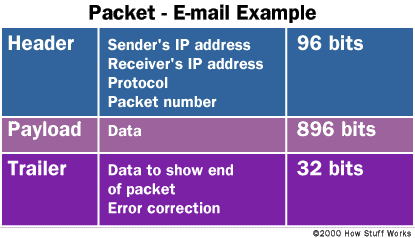It turns out that everything you do on the Internet involves packets. For example, every Web page that you receive comes as a series of packets, and every e-mail you send leaves as a series of packets. Networks that ship data around in small packets are called packet switched networks.
On the Internet, the network breaks an e-mail message into parts of a certain size in bytes. These are the packets. Each packet carries the information that will help it get to its destination -- the sender's IP address, the intended receiver's IP address, something that tells the network how many packets this e-mail message has been broken into and the number of this particular packet. The packets carry the data in the protocols that the Internet uses: Transmission Control Protocol/Internet Protocol (TCP/IP). Each packet contains part of the body of your message. A typical packet contains perhaps 1,000 or 1,500 bytes.
Each packet is then sent off to its destination by the best available route -- a route that might be taken by all the other packets in the message or by none of the other packets in the message. This makes the network more efficient. First, the network can balance the load across various pieces of equipment on a millisecond-by-millisecond basis. Second, if there is a problem with one piece of equipment in the network while a message is being transferred, packets can be routed around the problem, ensuring the delivery of the entire message.
Depending on the type of network, packets may be referred to by another name:
- frame
- block
- cell
- segment
Next, learn about the parts of packets and an example of how packets are applied.
Network Packet Structure
Most network packets are split into three parts:
Header - The header contains instructions about the data carried by the packet. These instructions may include:
- Length of packet (some networks have fixed-length packets, while others rely on the header to contain this information)
- Synchronization (a fewbits that help the packet match up to the network)
- Packet number (which packet this is in a sequence of packets)
- Protocol (on networks that carry multiple types of information, the protocol defines what type of packet is being transmitted: e-mail, Web page, streaming video)
- Destination address (where the packet is going)
- Originating address (where the packet came from)
Payload - Also called the body or data of a packet. This is the actual data that the packet is delivering to the destination. If a packet is fixed-length, then the payload may be padded with blank information to make it the right size.
Trailer - The trailer, sometimes called the footer, typically contains a couple of bits that tell the receiving device that it has reached the end of the packet. It may also have some type of error checking. The most common error checking used in packets is Cyclic Redundancy Check (CRC). CRC is pretty neat. Here is how it works in certain computer networks: It takes the sum of all the 1s in the payload and adds them together. The result is stored as a hexadecimal value in the trailer. The receiving device adds up the 1s in the payload and compares the result to the value stored in the trailer. If the values match, the packet is good. But if the values do not match, the receiving device sends a request to the originating device to resend the packet.
As an example, let's look at how an e-mail message might get broken into packets. Let's say that you send an e-mail to a friend. The e-mail is about 3,500 bits (3.5 kilobits) in size. The network you send it over uses fixed-length packets of 1,024 bits (1 kilobit). The header of each packet is 96 bits long and the trailer is 32 bits long, leaving 896 bits for the payload. To break the 3,500 bits of message into packets, you will need four packets (divide 3,500 by 896). Three packets will contain 896 bits of payload and the fourth will have 812 bits. Here is what one of the four packets would contain:
Each packet's header will contain the proper protocols, the originating address (the IP address of your computer), the destination address (the IP address of the computer where you are sending the e-mail) and the packet number (1, 2, 3 or 4 since there are 4 packets). Routers in the network will look at the destination address in the header and compare it to their lookup table to find out where to send the packet. Once the packet arrives at its destination, your friend's computer will strip the header and trailer off each packet and reassemble the e-mail based on the numbered sequence of the packets.


No comments :
Post a Comment